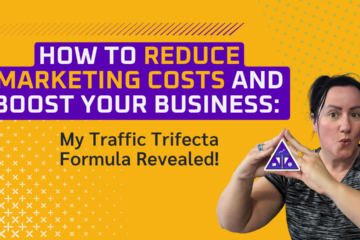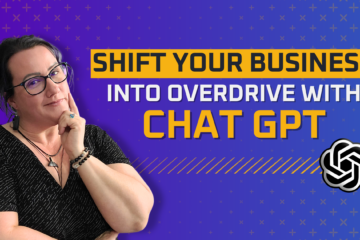How to Write Good Blog Posts: Key Steps You Should Follow
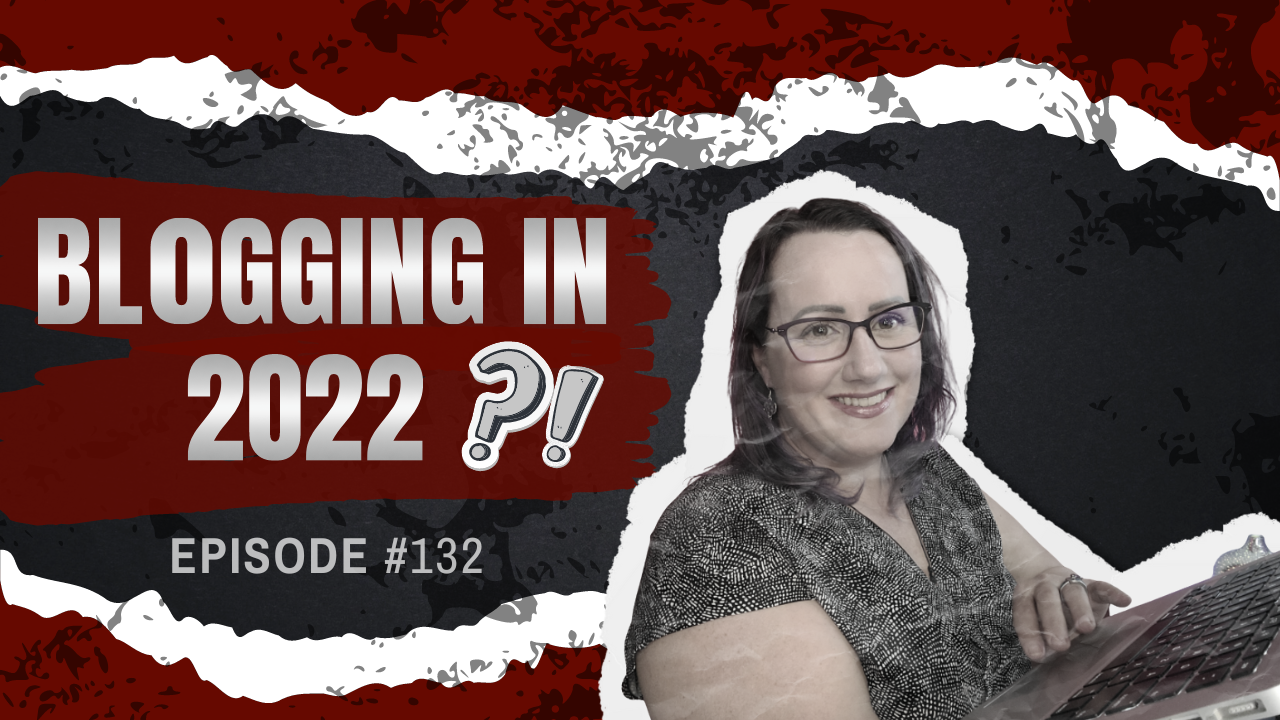
Looking for a way to write content that keeps readers engaged? Discover how to write good blog posts with these fool-proof steps!
Quick Links:
- TIP: How to Write Good Blog Posts [Infographic Download]
- Episode Overview – How Blogging Can Help Get Your Business on Top of a Google Search
- Personal Note from Jenn Neal on How to Write Good Blog Posts
- Blog Post – How to Write Good Blog Posts: The Key Steps You Should Follow
- Related Posts

TIP: How to Write Good Blog Posts
Time needed: 5 minutes
TIP: How to write good blog posts: 8 Step Guide
- Topic
Select your topic and keywords to optimize
- Research
Research about 3 other articles talking about similar topics, note which you can reference latertors with no tech skills make more money than those that do?
- Outline
Create an outline involving your main topic and about 3-5 sub points you’ll make
- Write body
Start with the body and map out each sub point with: why it’s important, a story and/or stat to support it, actionable steps
- Write the end & beginning
Write the conclusion which ties the topic to your product/ service
Write the intro: hookey headline that incorporates the keyword phrase you’re using - Dress it up
Add in images, quotes, stats, videos to break up the content
- Call to Action
Include CTA links and/or images throughout
- Optimize
Adjust any image alt text and copy to optimize for the keyword phrase you’ve selected
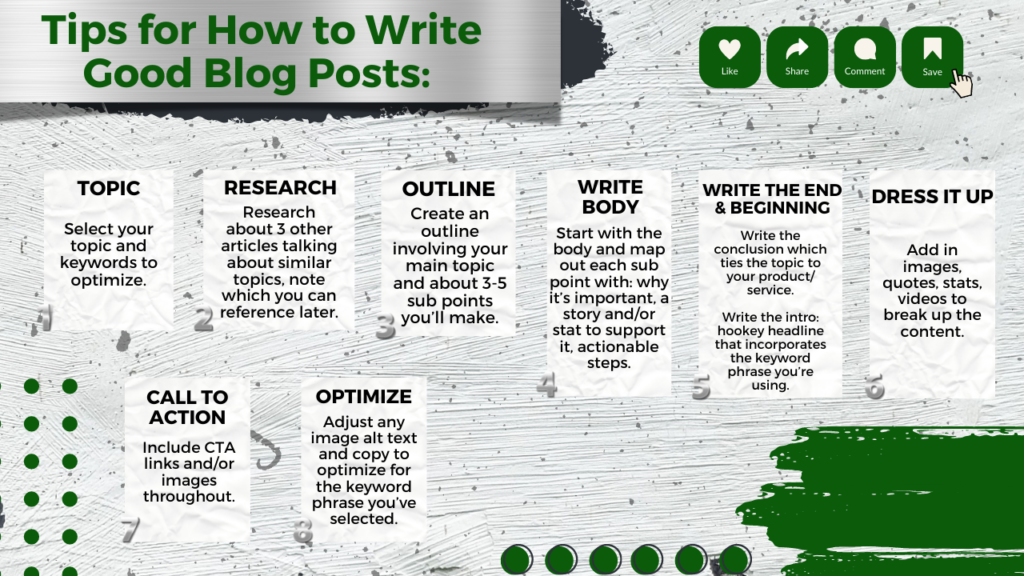

What’s In This Episode?
| I know that for most digital marketers, blog is just a 4 letter word, and writing a good blog post sounds like torture. But with them being so useful for marketing, I don’t want you to miss out on their benefits. I’m sharing tips to make your content marketing efforts easy, and effective, and giving you tips on how to write good blog posts without the hassle. Plus, I’m sharing a free, downloadable blog map to make creating your blog page easy! |
Jenn Neal on How to Write Good Blog Posts
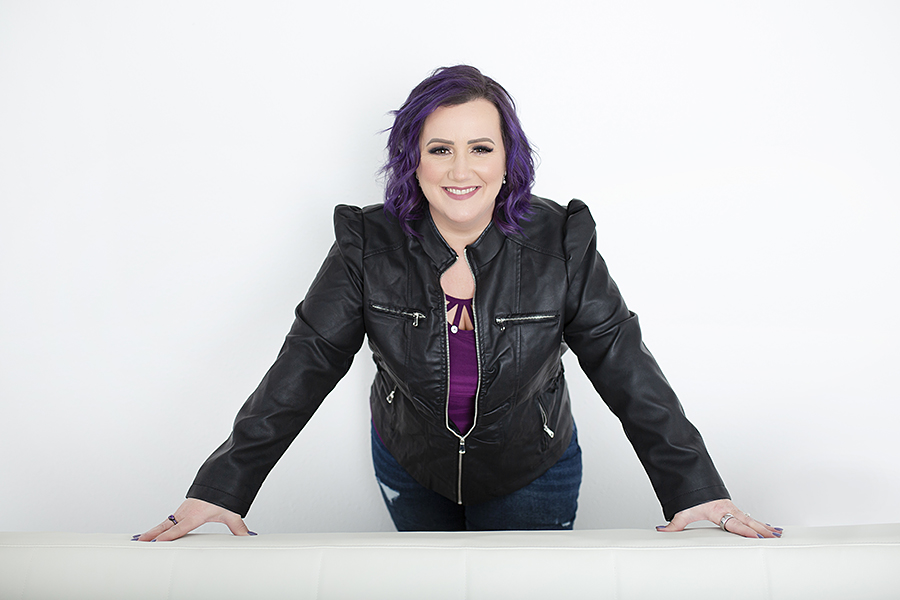
How to Write Good Blog Posts: The Key Steps You Should Follow
Have you ever come across a blog post and been wholly engaged the entire time? You’d swear you were being compelled because you couldn’t hold back from reading every word. And by the time you finished reading, you needed to try whatever you were reading about. Maybe it was a recipe or a new product… Either way, you needed it. Okay, obviously, there was no otherworldly source controlling your behavior. But how does someone learn how to write good blog posts that keep you engaged?
Writing blog posts and content is as easy as breathing for a small percentage of people. To others, the thought of writing anything, especially a post for a blog, sounds worse than getting a tooth pulled. But writing a good blog post doesn’t have to be a chore. What if I told you that I could give you a way to make writing blog posts, dare I say, enjoyable? Well, I can, and I will! (And, spoiler alert! I’ve even got a free blog map for you!) Let’s go!

Tips for How to Write Good Blog Posts as a Digital Marketer
We’re digital marketers… and well, let’s just admit that blog writing is not in our typical skill set. Most of us don’t even want to entertain such a minuscule 4 letter word. However, blogs really do help your business! And I swear, writing a good blog post does not have to be so elusive. It can be fun and easy! You just have to let your creative juices flow.
I get it; for people like my writer, this is usually a thoughtless task, but even the best writers are not strangers to writer’s block and will do whatever possible to procrastinate on writing. So I’m going to make the process of writing so much simpler and easier! Question is… where do you start? Well, with a topic, of course!
Finding a Good Topic
I’ve heard this question many times from our clients, and it’s a question I used to ask myself; how do I know what to write about? The thought of figuring out what to write about even sounds intimidating – but don’t shut your book just yet! I’m taking an educated guess and saying that you’ve been in front of a camera before, right? What did you talk about in front of the camera? So maybe this wasn’t even for your own podcast… but any topic you’re currently talking about in your business is an excellent topic to write about.
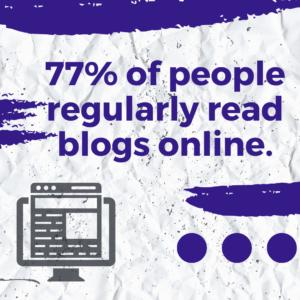
There are so many ways to decide what to write about. What questions are your clients or prospects asking? What are your competitors or favorite influencers in your industry talking about? One of my favorite things to do is to look at conferences happening in our industry and look at the speakers – and the topics they are presenting at the event. I know those will be hot topics, and then I share my take on it. Personally, I love checking out Neil Patel’s content for inspiration or any digital marketing conference.
My team and I also like to allow a little extra time in team meetings to tell stories, and more times than not, one of us points out points that would be great for an upcoming episode topic, and we add it to an ongoing list. However, you don’t just jump the gun with your topic… There’s a little research involved.
Researching Your Topic
Alright, so you know exactly what you want to talk about. Now, you’ve got to know what keywords to use! So the object of your research is to find out how your audience is searching for your topic. What specific terms and words are they using that relate to your topic? As you search for your keywords and which ones will work best, you’ll find that you will gain more ideas for subtopics that you didn’t think of before, but you’ll also find content with views that differ from your own.
Remember those influencers and competitors we referenced before? Well, they’re going to come in handy again! Check out google, YouTube, and other experts and see what people are putting out. And don’t forget to keep track of what you see because you’ll be able to link back to whatever you reference in your post! (Want to know more about topics and topic research? Check out our course – Content Connection Academy – and discover how to up your game and start making money from this content you’ll be producing!)
Get Organized
Now that you’ve got your topic and SEO keywords, it’s time to get organized! What do I mean? I mean, create an outline. When I make my outline, I like to be as detailed as possible so that I can hand it over to my writer, and she’ll know exactly what I talked about through the episode without even needing to watch any recordings. I let her take the outline and run with it – So long as I’ve done my part! So, I create a document and put down all the things I will discuss. I put in specific points, references (Yup! The ones you found earlier!), and stories I’m sharing. And yes, stories are a must!

Stories
Alright, I know you’ve got a ton of stories up your sleeve that are just itching to get out of your brain! And no, I’m not talking about once-upon-a-time fairytales. I’m talking about life experiences, the ups, and downs you’ve faced throughout your life that have led you to this point. Being vulnerable isn’t a bad thing! Sharing your stories helps your audience relate to you. They want to know that you’ve gone through what they’re experiencing right now. That they’re not alone in the world.
By adding these stories to your blog (and podcast episodes), your audience sees that you’re just like them; they’re not so different after all, and look at you! If you made it, so can they, and YOU can help them! So if you’re going to leave anything out, don’t let it be your story!
Alright, although I can sit here and talk about how important stories are all day, let’s move on!
How to Write Good Blog Posts
So, let’s get into the nitty gritty – the writing. No, no, don’t shut down on me; this is the best part! You’re going to see how your efforts thus far are going to benefit you!
The Meat of the Post
You’ve already got your topic, keywords, and outline- including those juicy stories! Now, it’s time to create your masterpiece. We like to start with the meat of the post. Yup, smack dab in the middle. Give me all the juicy details first! This consists of your 3 main tips.

Okay, totally outing myself here – when I would outline and record new episodes of The Content Toolbox, sometimes I’d get ahead of myself and create too many subtopics to talk about. Well, the episodes started getting a little long, so my video editor kindly suggested that we should probably keep it down to maybe 3 tips. You know, to give me room for little rants and extra fun bits I like to add in. Turns out, she’s kind of a genius, and I try to keep it down to 3 tips. Though I’m not always successful. 😉
Anyway, back on the subject – give details on each of your tips. Why are they important, how they can help, etc. Best to illustrate with a story or an example or actionable tips.
Create Your Conclusion, and Beginning
Now that you have the body of your text, write a conclusion or ending to your thoughts. Don’t forget to tie in your CTA. Grab your reader’s attention and show them that you’ve got the right tools for the job!
Once your ending is done (because we all love a good end to a story!), write your intro. You’ve got about 5 seconds to grab your reader when they start reading. If your introduction is boring, your reader will move on. So, think of fishing. You more than likely will not catch a fish if you don’t bait the hook. All in all, don’t forget to bait your hook!

Another great way to get your reader hooked is by using shorter sentences. No one likes long wordy sentences. And add in those keywords! Let your reader know that they will be given information on what they searched for by adding your keywords in the first paragraph. It’ll make it clear that they’re in the right place.
How Long Should It Be?
I know you’re reading this going; oh man! I’m going to be writing this thing for days! You’re totally not! Your post doesn’t have to be extremely long. You can also produce what we like to call a bite-size blog!
So, true story – I sometimes overcomplicate things. Not purposely, but it’s just how my brain works. I like to do all the things all the time! Typically, we were trying to keep our blog posts between 1500-2000 words. But we realized it took a lot of time and effort. And based on how we use the blog, we didn’t need to have something that long. So, the team and I sat down and started strategizing how we could improve. Thus, a bite-size blog was born. It would be around 800 words, be SEO optimized, and still provide a ton of great value that we use to create engagement and conversions from Social Media Marketing.
What I mean here is that the length of your blog should depend on what you’re using it for. It should be related to the end goal. This is a great reference on target lengths and use cases.
Now, onto some more exciting, fun pieces of your blog!

Make It Visually Sexy
Okay, while this piece of the puzzle isn’t necessarily about how to write good blog posts, it’s something that is often overlooked. Your content is only part of the equation. Let’s face it. We live in a very visual world. Even social media is a mass of pictures and videos. So, you don’t want your blog to just sound good… you want to make it look good too! Like, sexy good. 😊 Think of it like going to a restaurant. If the food doesn’t look good, you don’t want to try it.
A blog page is the same way! If it doesn’t look good, people aren’t going to spend the time engaging with it! The last thing you want to do is overwhelm your readers with a ton of text. Give them little bits and pieces to look at and entice them. You probably already guessed that I have a formula for this!
Here is the format we follow here at Formula Done! This outlines just the 3 main topics I mentioned, but you can add more topics if you need. Don’t forget to grab your copy of this image for future reference!
And, if you need help deciding what these images should look like, you definitely want to check out our course – Content Connection Academy. The Content Connection Academy will give you all the tools you need – topic research info, the kinds of graphics to use, and even how to create stories around your content. And the beauty of it? You won’t only be using this information to find out how to write good blog posts. You’ll be able to extend this into your social media marketing to start generating income. Which reminds me!
Don’t Forget the CTA!
While we’re on the topic of making your blog look good and a way to earn income from your assets, let’s not forget about the Calls to Action (CTAs!) You’ll want to be sure you’re adding a call to action throughout your blog post. Giving your audience a clear call to action is imperative. They will be reading about your products, so you want them to clearly understand where they can find your product or you!
I’m sure you’ve noticed a few banners on this page so far… and honestly, each of our blog posts has them. Why? Because we’re confident that you’ll love what we have to offer. So, be confident and know your audience wants what you offer! Then, tell them exactly where to find it!
And Last but Not Least
Have fun! Don’t stress out and overcomplicate the process (I can do this for both of us!). Trust in your instincts and follow the process above, and you’ll have a foolproof plan of how to write good blog posts!
Before I go, if you’re feeling intimidated and want something to help guide you through this process, don’t forget to check out the Content Connection Academy! It’ll give you all the tools you need to make this happen in little bite-size chunks that make it easier to accomplish (you know, so you’re not thinking of all the things all at once!) And don’t forget to check out this week’s episode of The Content Toolbox! You never know what extra little nuggets you’ll pick up from it!
Related Posts
How to Write a Killer Blog Post in Under 60 Minutes (Yes, Really)
What is the Ideal Length for a Blog Post in 2022? (Complete Guide)
Guest Blogging Opportunities – How To Build Your Audience
How Can Blogging Help Promote A Business?
What type of content (articles, advertorials, blogs, content, etc.) are you consistently creating and posting on your website?

